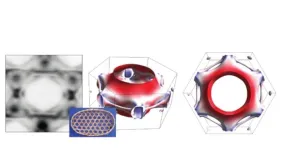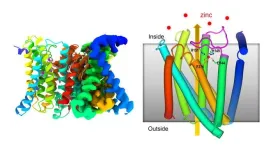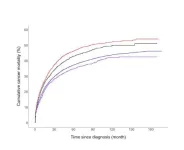(Press-News.org) An international research team has succeeded for the first time in measuring the electron spin in matter - i.e., the curvature of space in which electrons live and move - within "kagome materials", a new class of quantum materials.
The results obtained - published in Nature Physics - could revolutionise the way quantum materials are studied in the future, opening the door to new developments in quantum technologies, with possible applications in a variety of technological fields, from renewable energy to biomedicine, from electronics to quantum computers.
Success was achieved by an international collaboration of scientists, in which Domenico Di Sante, professor at the Department of Physics and Astronomy "Augusto Righi", participated for the University of Bologna as part of his Marie Curie BITMAP research project. He was joined by colleagues from CNR-IOM Trieste, Ca' Foscari University of Venice, University of Milan, University of Würzburg (Germany), University of St. Andrews (UK), Boston College and University of Santa Barbara (USA).
Through advanced experimental techniques, using light generated by a particle accelerator, the Synchrotron, and thanks to modern techniques for modelling the behaviour of matter, the scholars were able to measure electron spin for the first time, related to the concept of topology.
"If we take two objects such as a football and a doughnut, we notice that their specific shapes determine different topological properties, for example because the doughnut has a hole, while the football does not," Domenico Di Sante explains. "Similarly, the behaviour of electrons in materials is influenced by certain quantum properties that determine their spinning in the matter in which they are found, similar to how the trajectory of light in the universe is modified by the presence of stars, black holes, dark matter, and dark energy, which bend time and space."
Although this characteristic of electrons has been known for many years, no one had until now been able to measure this "topological spin" directly. To achieve this, the researchers exploited a particular effect known as "circular dichroism": a special experimental technique that can only be used with a synchrotron source, which exploits the ability of materials to absorb light differently depending on their polarisation.
Scholars have especially focused on "kagome materials", a class of quantum materials that owe their name to their resemblance to the weave of interwoven bamboo threads that make up a traditional Japanese basket (called, indeed, "kagome"). These materials are revolutionising quantum physics, and the results obtained could help us learn more about their special magnetic, topological, and superconducting properties.
"These important results were possible thanks to a strong synergy between experimental practice and theoretical analysis," adds Di Sante. "The team's theoretical researchers employed sophisticated quantum simulations, only possible with the use of powerful supercomputers, and in this way guided their experimental colleagues to the specific area of the material where the circular dichroism effect could be measured.
The study was published in Nature Physics with the title "Flat band separation and robust spin Berry curvature in bilayer kagome metals". The first author of the study is Domenico Di Sante, a researcher at the "Augusto Righi" Department of Physics and Astronomy of the University of Bologna. He worked with scholars from the CNR-IOM of Trieste, the Ca' Foscari University of Venice, the University of Milan, the University of Würzburg (Germany), the University of St. Andrews (UK), the Boston College and the University of Santa Barbara (USA).
END
Quantum materials: Electron spin measured for the first time
2023-06-09
ELSE PRESS RELEASES FROM THIS DATE:
Seismic Waves tell lithospheric delamination mechanism in south China
2023-06-09
A research team led by Prof. ZHANG Haijiang from the University of Science and Technology of China (USTC) of the Chinese Academy of Sciences, and Prof. HOU Zengqian from Chinese Academy of Geological Sciences, revealed the seismically imaged lithospheric delamination and its controls on the Mesozoic Magmatic Province in South China by using a new joint seismic inversion algorithm. The study was published in Nature Communications.
Based on the latest developed seismic joint inversion algorithm, the researchers made use of the seismic body wave travel time, surface wave dispersion ...
Program for underrepresented undergraduate students in STEM receives NIH funding
2023-06-09
Alexandra Hanlon, director of the Virginia Tech Center for Biostatistics and Health Data Science, was recently awarded a $1.25 million grant from the National Institutes of Health (NIH) for a summer program aimed at promoting and diversifying the field of collaborative biostatistics.
The Collaborative Undergraduate Biostatistics Experience (CUBE), an eight-week summer program geared toward underrepresented undergraduate students, will receive $250,000 per year over the next five years through the NIH Research Education Program.
This R25 award, which is funded in a joint effort ...
USTC enhances fluorescence brightness of single silicon carbide spin color centers
2023-06-09
In a study published online in Nano Letters, the team led by Prof. LI Chuanfeng and Dr. XU Jinshi from the University of Science and Technology of China of the Chinese Academy of Sciences made progress in enhancing the fluorescence of single silicon carbide spin defects. The researchers leveraged surface plasmons to markedly boost the fluorescence brightness of single silicon carbide double vacancy PL6 color centers, leading to an improvement in the efficiency of spin control using the properties of co-planar waveguides. This low-cost method neither calls for complex micro-nano processing ...
Researchers determine quantitative composition of ultrahigh-pressure fluid in deep subduction zones
2023-06-09
In a study published in PNAS, Prof. XIAO Yilin’s group from the University of Science and Technology of China (USTC) of the Chinese Academy of Sciences (CAS) quantitatively determined, for the first time, the chemical composition of supercritical fluids in deep subduction zones, through 3D imaging modelling of ultrahigh-pressure (UHP) multiphase fluid inclusions, and revealed the important role of supercritical fluids in the cycling of carbon and sulfur in subduction zones, which is of great importance ...
USTC reveals reconfiguration process of solar eruptions
2023-06-09
Recently, a research team led by Prof. GOU Yanyu from the University of Science and Technology of China (USTC) of the Chinese Academy of Sciences (CAS) found that the solar outburst structure undergoes a complex reconfiguration evolution during the early outbursts, thus making important advances in the study of solar outburst activity. This study was published in Nature Astronomy.
In classical images, the core structure of a solar eruption is a magnetic rope consisted of spirally wound magnetic lines. When the eruption begins, the magnetic ropes around the core are transformed by magnetic reconnection ...
DNA facilitates escape from metastability
2023-06-09
Prof. LIANG Haojun from the University of Science and Technology of China (USTC) of the Chinese Academy of Sciences (CAS) proposed a new method to escape from metastability for self-assembly in a far-from-equilibrium system. The study was published in PNAS.
Self-assembly refers to the process in which assembled primitive elements (molecules, nanoparticles, etc.) spontaneously form ordered structures through non-covalent interactions. Its excellent capacity to create new materials has drawn attention. In an ...
Single quantum bit achieves complex systems modeling
2023-06-09
A team led by Academician GUO Guangcan from the University of Science and Technology of China (USTC) of the Chinese Academy of Sciences (CAS), with collaborative efforts from the University of Manchester, and Nanyang Technological University, has achieved new progress in applying quantum technologies in complex systems modeling. The results were published in Nature Communications on May 6.
Stochastic modeling can help us to predict the future behavior of complex processes, which are non-Markovian. In order to simulate a non-Markovian process, a memory is of necessity to store a large amount of observed information about the past of the system. However, ...
Zinc transporter has built-in self-regulating sensor
2023-06-09
UPTON, NY — Scientists at the U.S. Department of Energy’s (DOE) Brookhaven National Laboratory have determined the atomic-level structure of a zinc-transporter protein, a molecular machine that regulates levels of this crucial trace metal micronutrient inside cells. As described in a paper just published in Nature Communications, the structure reveals how the cellular membrane protein shifts its shape to move zinc from the environment into a cell, and temporarily blocks this action automatically when zinc levels inside the cell get too high.
“Zinc is important for many biological ...
New model offers a way to speed up drug discovery
2023-06-09
CAMBRIDGE, MA — Huge libraries of drug compounds may hold potential treatments for a variety of diseases, such as cancer or heart disease. Ideally, scientists would like to experimentally test each of these compounds against all possible targets, but doing that kind of screen is prohibitively time-consuming.
In recent years, researchers have begun using computational methods to screen those libraries in hopes of speeding up drug discovery. However, many of those methods also take a long time, as most of them calculate each target protein’s ...
Black, Hispanic survivors of breast cancer have higher death rates from second cancers
2023-06-09
Hispanic and non-Hispanic Black female survivors of breast cancer experience higher death rates after being diagnosed with a second primary cancer than members of other ethnic and racial groups, according to recent research from investigators at the Johns Hopkins Kimmel Cancer Center.
In a study of nearly 40,000 adult survivors of breast cancer, the risk of death from a second cancer was 12% higher among non-Hispanic Black survivors and 8% higher among Hispanic survivors compared with non-Hispanic white survivors. Survivors in racial and ethnic minorities were diagnosed with second cancers ...




